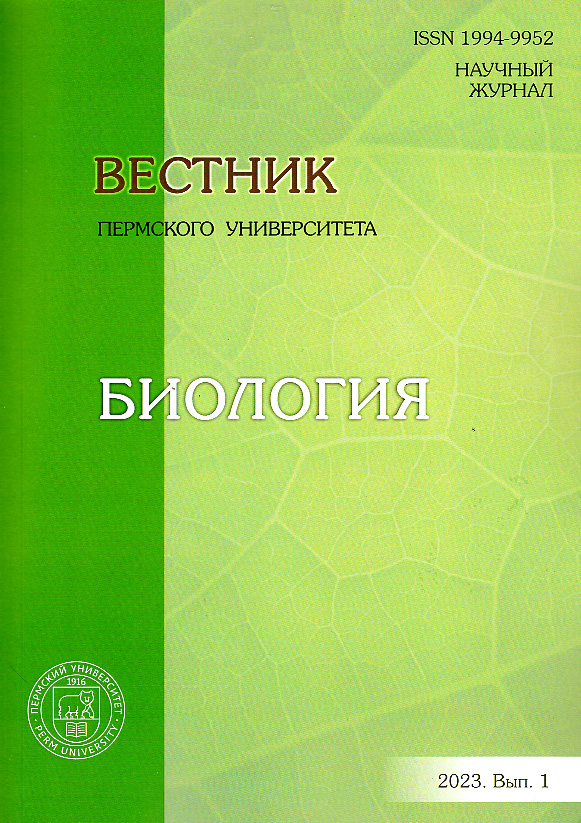Role for the microbial translocation in the chronic immune activation and immunodeficiency development during HIV-infection
Main Article Content
Abstract
Article Details
References
Сайдакова E.В. Роль отдельных субпопуляций CD4+ Т-лимфоцитов в патогенезе ВИЧ-инфекции // Вестник Пермского университета. Сер. Биология. 2020. Вып. 3. С. 236–246. DOI: 10.17072/1994-9952-2020-3-236-246.
Blanco J.R. et al. Impact of HIV infection on aging and immune status // Expert Rev Anti Infect Ther. 2021. Vol. 19. P. 719–731.
Brenchley J.M. et al. Microbial translocation is a cause of systemic immune activation in chronic HIV in-fection // Nature Medicine. 2006. Vol. 12. P. 1365–1371.
Broussard S.R. et al. Simian immunodeficiency virus replicates to high levels in naturally infected African green monkeys without inducing immunologic or neurologic disease // Journal of Virology. 2001. Vol. 75. P. 2262–2275.
Dillon S.M., Frank D.N., Wilson C.C. The gut microbiome and HIV-1 pathogenesis: a two-way street // AIDS. 2016. Vol. 30. P. 2737–2751.
Fromentin R., Chomont N. HIV persistence in subsets of CD4+ T cells: 50 shades of reservoirs // Semin Immunol. 2021. Vol. 51. P. 101438.
Giorgi J.V. et al. Shorter survival in advanced human immunodeficiency virus type 1 infection is more closely associated with T lymphocyte activation than with plasma virus burden or virus chemokine coreceptor usage // The Journal of Infectious Diseases. 1999. Vol. 179. P. 859–870.
Giorgi J.V. et al. Elevated levels of CD38+ CD8+ T cells in HIV infection add to the prognostic value of low CD4+ T cell levels: results of 6 years of follow-up. The Los Angeles Center, Multicenter AIDS Cohort Study // Journal of Acquired Immune Deficiency Syndromes. 1993. Vol. 6. P. 904–912.
Green D.R., Droin N., Pinkoski M. Activation-induced cell death in T cells // Immunol. Rev. 2003. Vol. 193. P. 70–81.
Grossman Z. et al. CD4+ T-cell depletion in HIV infection: are we closer to understanding the cause? // Nature Medicine. 2002. Vol. 8. P. 319–323.
Hazenberg M.D. et al. T cell depletion in HIV-1 infection: how CD4+ T cells go out of stock // Nature Immunology. 2000. Vol. 1. P. 285–289.
He Y. et al. Persistent chronic immune activation in HIV/HBV-coinfected patients after antiretroviral therapy // J. Viral. Hepat. 2021. Vol. 28. P. 1355–1361.
Hunt P.W. et al. T cell activation is associated with lower CD4+ T cell gains in human immunodeficiency virus-infected patients with sustained viral suppression during antiretroviral therapy // The Journal of Infectious Diseases. 2003. Vol. 187. P. 1534–1543.
Leyre L. et al. Abundant HIV-infected cells in blood and tissues are rapidly cleared upon ART initiation during acute HIV infection // Sci. Transl. Med. 2020. Vol. 12. P. eaav3491.
Liu Z. et al. Elevated CD38 antigen expression on CD8+ T cells is a stronger marker for the risk of chron-ic HIV disease progression to AIDS and death in the Multicenter AIDS Cohort Study than CD4+ cell count, sol-uble immune activation markers, or combinations of HLA-DR and CD38 expression // Journal of Acquired Immune Deficiency Syndromes and Human Retrovirology. 1997. Vol. 16. P. 83–92.
Mattapallil J.J. et al. Massive infection and loss of memory CD4+ T cells in multiple tissues during acute SIV infection // Nature. 2005. Vol. 434. P. 1093–1097.
Mehandru S. et al. Primary HIV-1 infection is associated with preferential depletion of CD4+ T lympho-cytes from effector sites in the gastrointestinal tract // J. Exp. Med. 2004. Vol. 200. P. 761–770.
Milon G., et al. A delayed-type hypersensitivity reaction initiated by a single T lymphocyte // Agents Ac-tions. 1981. Vol. 11. P. 612–614.
Mudd J.C., Brenchley J.M. Gut Mucosal Barrier Dysfunction, Microbial Dysbiosis, and Their Role in HIV-1 Disease Progression // The Journal of Infectious Diseases. 2016. Vol. 214, Suppl. 2. P. S58–66.
Ndhlovu Z.M. et al. Augmentation of HIV-specific T cell function by immediate treatment of hypera-cute HIV-1 infection // Sci. Transl. Med. 2019. Vol. 11. P. eaau0528.
Palesch D. et al. Sooty mangabey genome sequence provides insight into AIDS resistance in a natural SIV host // Nature. 2018. Vol. 553. P. 77–81.
Tesselaar K. et al. Lethal T cell immunodeficiency induced by chronic costimulation via CD27-CD70 in-teractions // Nat. Immunol. 2003. Vol. 4. P. 49–54.
Veazey R.S. et al. Gastrointestinal tract as a major site of CD4+ T cell depletion and viral replication in SIV infection // Science. 1998. Vol. 280. P. 427–431.




